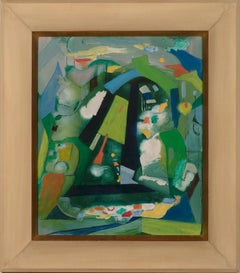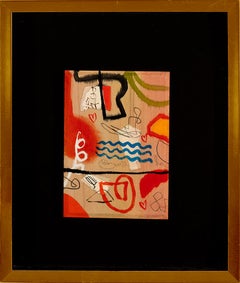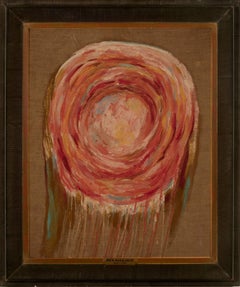Want more images or videos?
Request additional images or videos from the seller
1 of 7
James Lechay"Seriously!"20th Cent.
20th Cent.
$14,375
£10,997.01
€12,647.83
CA$20,529.33
A$22,628.93
CHF 11,692.52
MX$270,512.86
NOK 147,091.15
SEK 138,244.74
DKK 94,468.14
About the Item
Signed lower right
Jim’s of Lambertville is proud to offer this artwork by:
Rex Ashlock (1918 – 1999)
Born in Spokane, Washington in 1918 Rex Ashlock was known for his abstract, figurative expressionist paintings. Ashlock's works are recognized for their “broad fields of single colors with subtle tonal changes, some characterized by moon-like shapes and others by calligraphic emblems”. The most frequent subject of Ashlock’s works was the female form which served as “his primary source of inspiration”. He studied at The California School of Fine Arts in San Francisco with fellow artist, David Park, before eventually teaching there. In 1957 he left for New York to pursue the bohemian lifestyle cultivating in the city. In his free time, he studied the works and writings of American Abstract Expressionists, European figurative painters, and German Expressionists. He died in 1999 in San Francisco after moving back in order to live closer to his family.
Source: Peter Hastings Falk, “One Grain of Sand, Unstained: The Life and Art of Rex Ashlock”
- Creator:James Lechay (1907-2001)
- Creation Year:20th Cent.
- Dimensions:Height: 35 in (88.9 cm)Width: 30 in (76.2 cm)Depth: 2 in (5.08 cm)
- More Editions & Sizes:Framed Size 36" x 31"Price: $14,375
- Medium:
- Movement & Style:
- Period:
- Condition:
- Gallery Location:Lambertville, NJ
- Reference Number:Seller: JOL112319631stDibs: LU3745769621
About the Seller
5.0
Vetted Professional Seller
Every seller passes strict standards for authenticity and reliability
Established in 1997
1stDibs seller since 2014
39 sales on 1stDibs
Typical response time: 23 hours
- ShippingRetrieving quote...Shipping from: Lambertville, NJ
- Return Policy
Authenticity Guarantee
In the unlikely event there’s an issue with an item’s authenticity, contact us within 1 year for a full refund. DetailsMoney-Back Guarantee
If your item is not as described, is damaged in transit, or does not arrive, contact us within 7 days for a full refund. Details24-Hour Cancellation
You have a 24-hour grace period in which to reconsider your purchase, with no questions asked.Vetted Professional Sellers
Our world-class sellers must adhere to strict standards for service and quality, maintaining the integrity of our listings.Price-Match Guarantee
If you find that a seller listed the same item for a lower price elsewhere, we’ll match it.Trusted Global Delivery
Our best-in-class carrier network provides specialized shipping options worldwide, including custom delivery.More From This Seller
View All"Tarus"
By Joseph Meierhans
Located in Lambertville, NJ
Jim’s of Lambertville is proud to offer this artwork.
Signed Lower Right
Joseph Meierhans (1890 - 1980)
Joseph Meierhans is one of the most important modernist painters associate...
Category
20th Century Abstract Abstract Paintings
Materials
Masonite, Oil
$15,650
"Jewel"
By Gershon Benjamin
Located in Lambertville, NJ
Jim’s of Lambertville is proud to offer this artwork by:
Gershon Benjamin (1899 - 1985)
An American Modernist of portraits, landscapes, still lives, and the urban scene, Gershon ...
Category
1940s Modern Portrait Paintings
Materials
Canvas, Oil
"Carioca No. 1"
By Lamar Briggs
Located in Lambertville, NJ
Lamar Briggs (1935 – 2015)
Abstract artist, Lamar Briggs, was born November 13, 1935 in Lafayette, Louisiana. He initially attended the University of Southern Louisiana for architec...
Category
20th Century Abstract Abstract Paintings
Materials
Mixed Media, Panel
"Pink"
By Rex Ashlock
Located in Lambertville, NJ
Jim’s of Lambertville is proud to offer this artwork by:
Rex Ashlock (1918 - 1999)
Born in Spokane, WA on Aug. 23, 1918. Ashlock moved to San Francisco in 1937 and was a copy boy...
Category
1960s Abstract Abstract Paintings
Materials
Canvas, Oil
$11,200
"Red Eight"
By Joseph Amar
Located in Lambertville, NJ
Jim’s of Lambertville is proud to offer this artwork by:
Joseph Amar (1954 – 2001)
Joseph Amar was born in Casablanca, Morocco in 1954 to a Sephardic Jewish father and a Spanish mo...
Category
1970s Abstract Mixed Media
Materials
Paper, Mixed Media
"Going Down"
By Joseph Amar
Located in Lambertville, NJ
Jim’s of Lambertville is proud to offer this artwork by:
Joseph Amar (1954 – 2001)
Joseph Amar was born in Casablanca, Morocco in 1954 to a Sephardic Jewish father and a Spanish mo...
Category
1970s Abstract Mixed Media
Materials
Paper, Mixed Media
You May Also Like
Echoes of the Atelier XII
Located in London, GB
Echoes of the Atelier XII, acrylic on canvas mounted on board, Florentine School (circa 1980s-90s). This gallery has acquired a number of paintings through an intermediary of an agei...
Category
1980s Modern Portrait Paintings
Materials
Canvas, Oil, Board
Echoes of the Atelier I
Located in London, GB
Echoes of the Atelier I, acrylic on board, Florentine School (circa 1980s-90s). This gallery has acquired a number of paintings through an intermediary of an ageing art professor fro...
Category
1980s Modern Portrait Paintings
Materials
Acrylic, Board
Echoes of the Atelier XVI
Located in London, GB
Echoes of the Atelier XVI, acrylic on canvas mounted on board, Florentine School (circa 1980s-90s). This gallery has acquired a number of paintings through an intermediary of an agei...
Category
1980s Modern Portrait Paintings
Materials
Canvas, Acrylic, Board
Echoes of the Atelier VI
Located in London, GB
Echoes of the Atelier VI, acrylic on canvas mounted on board, Florentine School (circa 1980s-90s). This gallery has acquired a number of paintings through an intermediary of an agein...
Category
1980s Modern Portrait Paintings
Materials
Canvas, Acrylic, Board
Echoes of the Atelier II
Located in London, GB
Echoes of the Atelier II, acrylic on board, Florentine School (circa 1980s-90s). This gallery has acquired a number of paintings through an intermediary of an ageing art professor fr...
Category
1980s Modern Portrait Paintings
Materials
Acrylic, Board
Echoes of the Atelier IV
Located in London, GB
Echoes of the Atelier IV, acrylic on canvas mounted on board, Florentine School (circa 1980s-90s). This gallery has acquired a number of paintings through an intermediary of an agein...
Category
1980s Modern Portrait Paintings
Materials
Canvas, Acrylic, Board


